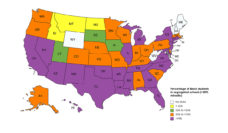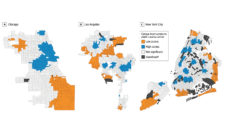The Brown v. Board of Education 1954 ruling deemed segregation to be unconstitutional. Yet school segregation is still the norm for many American children. School choice advocates contend that the availability of school choice (the ability for parents to freely choose a school for their children) decreases segregation. Others argue that school choice increases segregation, as parents are likely to select a school where their racial group is well-represented. Understanding how school choice affects segregation is critical as public policy makers consider legislation that expands school choice and as schools strive toward integration.
Does school choice, the ability for parents to freely choose a school for their children, impact segregation? And if so, why? In our recent paper published in the Proceedings of the National Academy of Sciences of the United States of America, we examined these questions by 1) presenting fictional school options to 1,600+ Black and White parents, 2) measuring their preferences for schools based on the schools’ characteristics, and 3) simulating a hypothetical society where 4,000 Black and White parents chose schools for their children over a 20-year period based on these distinct preferences. The schools we presented to the group of 1,600+ parents varied in characteristics such as their performance rating, teacher experience, prevalence of poverty among the students, length of commute, and the racial demographics of the student body.
When parents can choose freely among different sets of schools, we found something crucial: Black and White parents differed in their school preferences, leading to increased segregation within our simulation. Black parents exhibited a stronger preference for top-ranked schools, while White parents had a stronger preference for predominantly White (instead of Black) schools with a short commute. The findings were most evident among high-income Black and White households.
While the results showed that student racial makeup was important to both Black and White parents, school choice increased segregation even when Black and White parents were indifferent to the racial makeup of a school.
We reason this difference in preference occurs because of historical differences in status between Black and White demographics in America. Black people have historically been assigned a lower status than White people. Lower-status groups tend to prioritize altering their status through their choices, such as through their school choices for their children. Since education at a top-ranked school is seen to change social status, we reason that Black parents, particularly high-income Black parents, are more willing to prioritize sending their children to a top-ranked school than their White counterparts. In contrast, White parents, particularly upper-income White parents, are less focused on changing social status. For this reason, they can prioritize convenience factors in their schools, such as seeking a shorter commute time.
Ultimately, we found that when these differences occur in large populations (i.e., the hypothetical society of 4,000 Black and White parents), segregation occurs. This happens even if Black and White parents are not intentionally avoiding schools where their child will be in the racial majority. While the results showed that student racial makeup was important to both Black and White parents, school choice increased segregation even when Black and White parents were indifferent to the racial makeup of a school.
The implications of the finding that school choice can increase segregation because Black and White parents have distinct school preferences are notable. This finding suggests that schools that aim to have a diverse student body should speak to these unique preferences when recruiting Black and White students. For example, a school may emphasize its resources that lessen the parent’s commute in getting their child to the school (e.g., carpool) for White parents. It may also emphasize its extracurricular college-prep courses for Black parents. This may encourage both groups to select the same school for their children, ultimately fostering diversity. Additionally, this work suggests that public policy makers who are considering expanding school choice policies should weigh the benefits of doing so against the potential negative consequence of increasing segregation.
Photo via Getty Images
















